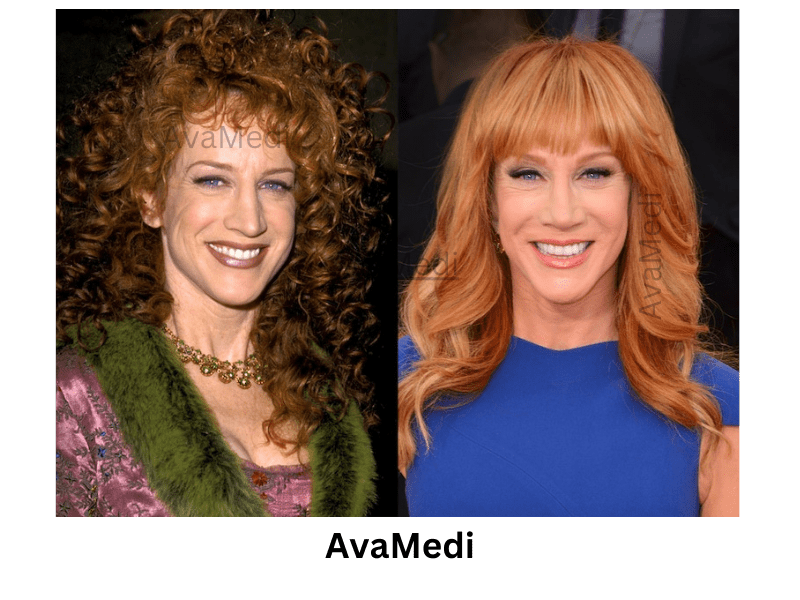جاهای دیدنی تهران
جاهای دیدنی تهرانجاهای دیدنی تهران
جاهای دیدنی تهرانLiposuction vs Tummy Tuck Pain In Iran
source:Liposuction vs Tummy Tuck Pain In Iran
Comparing the pain associated with Liposuction and Tummy Tuck procedures in Iran is crucial for individuals seeking cosmetic enhancements. While Tummy Tucks are often considered more painful due to their invasive nature, individual experiences can vary, and a consultation with a qualified plastic surgeon is essential to explore personalized pain management options.
**Comparing Liposuction vs Tummy Tuck Pain in Iran:**
Assessing the pain associated with these procedures requires consideration of individual tolerance and experiences. Tummy Tucks are generally perceived as more painful due to their invasive nature and extensive tissue manipulation. However, consulting with a plastic surgeon is crucial to discuss individual circumstances and explore personalized pain management options.
**Tummy Tuck in Iran:**
A Tummy Tuck, or Abdominoplasty, involves removing excess skin and fat from the abdominal area while tightening muscles. The procedure includes anesthesia, muscle tightening, precise removal of excess skin and fat, and closing the incision. Patients commonly report moderate to severe pain in the initial days post-surgery, with prescribed medications aiding in pain management throughout the recovery period, which can span several weeks.
**Liposuction in Iran:**
Liposuction is a minimally invasive procedure targeting localized fat using a thin tube called a cannula. The procedure involves smaller incisions and no muscle tightening. Patients typically experience mild to moderate discomfort, and the recovery period is relatively shorter, ranging from a few days to a couple of weeks.
**Comparing Tummy Tuck Pain to C-Section:**
While individual experiences vary, plastic surgeons commonly assert that C-sections tend to be more painful than most Tummy Tucks. Post-Tummy Tuck discomfort is dynamic, with pain peaking in the first week and gradually subsiding.
**Factors Influencing Pain Levels:**
Various factors, including incision size, fat removal extent, individual pain tolerance, post-operative adherence, complications, pre-surgery health, lifestyle choices, and pre-surgery habits, contribute to the symphony of pain experienced post-surgery.
**Managing the Symphony of Pain:**
Effective pain management involves individualized approaches, prescribed medications, holistic recovery methods, and open communication with the surgical team.
**Conclusion:**
Understanding the factors shaping post-surgical pain in Liposuction vs Tummy Tuck procedures in Iran provides insights into the recovery journey. While Tummy Tucks may entail more pain and a longer recovery, offering comprehensive body contouring benefits, Liposuction provides less discomfort and a quicker recovery, focusing on localized fat removal. The best choice depends on individual body goals, pain tolerance, and consultation with a qualified plastic surgeon, emphasizing thorough research and consultations before making a decision.
Celebrities Who Are Open About Their Nose Jobs
SOURCE:Celebrities Who Are Open About Their Nose Jobs
Tyra Banks
The worldwide supermodel Tyra Banks stated she had her nose job at the beginning of her professional career. The reason behind her nose job, as she explains, is the growing bone in her nose. According to her, her nose broke when she was a little kid, and her nose never got treated because she didn’t feel any pain. Her nose didn’t bother her, but later on, it caused complications for her. She decided to fix it, but she has also added cosmetic surgery.
Tyra Banks before and after nose job
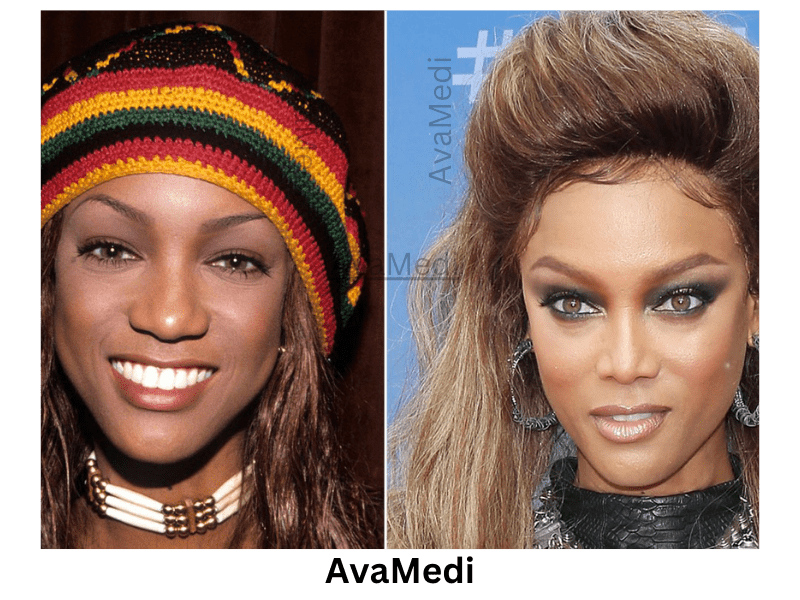
Jillian Michaels
Jillian Michaels talked about undergoing a nose job at the age of 16 and the fact that it changed her life. Furthermore, she spells out that she got bullied in high school because of her looks, and after having the nose job procedure, she built self-confidence.
Jillian Michaels before and after nose job
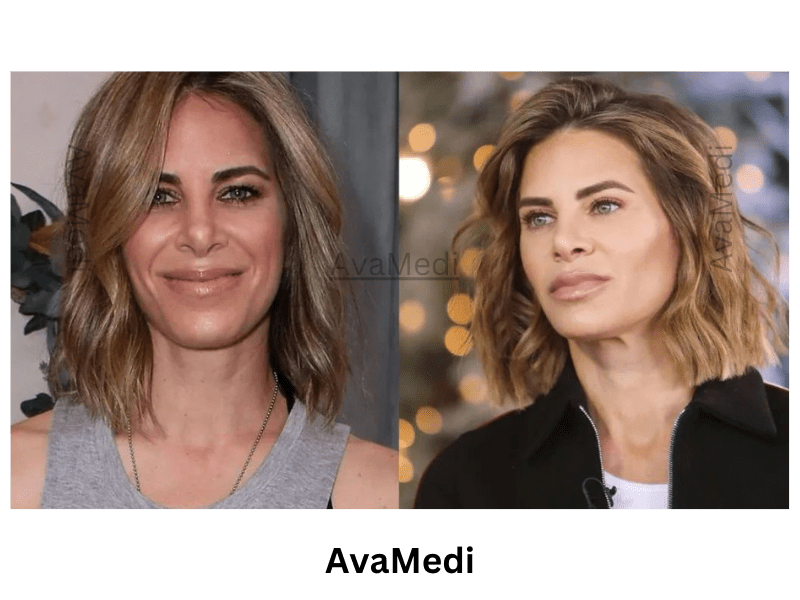
Courtney Love
Courtney Love clarified her rhinoplasty procedure in the mid-1980s. She said she had a really big nose and it had caused problems for her in her career. She broke down that she fixed her nose willingly and this procedure was definitely beneficial for her.
Courtney Love before and after nose job
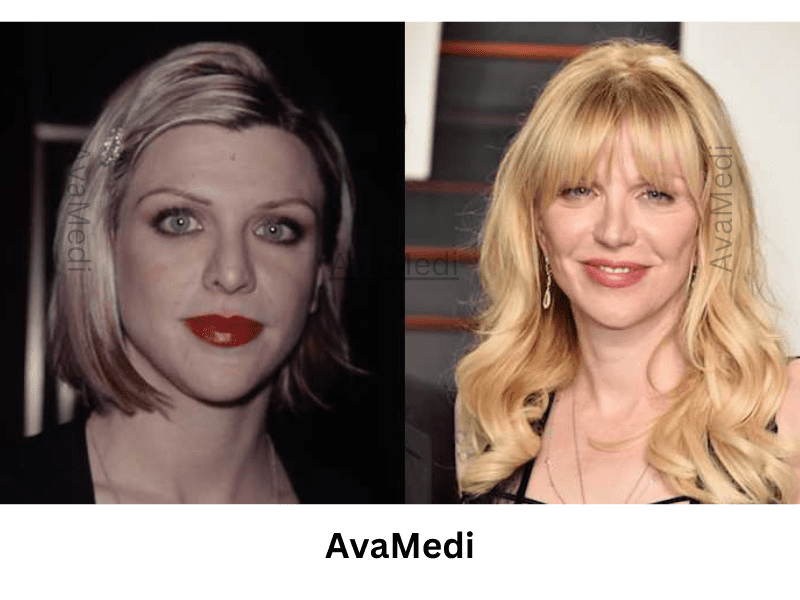
Ashley Tisdale
Ashley Tisdale, the famous American singer and actress, stated in an interview with People Magazine in 2007 that she had undergone plastic surgery to correct a deviated septum. She has also explained that she had undergone nose job surgery because of breathing problems.
Ashley Tisdale before and after nose job
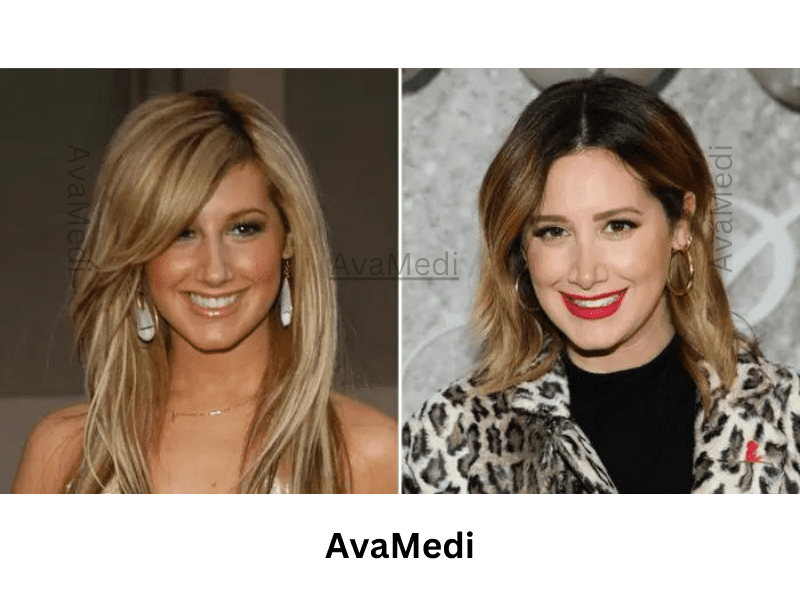
Jennifer Grey
Jennifer Grey has also unraveled the experience of having two nose jobs in her memoir, “Out of the Corner.” When she was 25, she wasn’t getting her desired roles, and back then, her mother recommended she have a rhinoplasty procedure. Later on Jennifer Grey admitted she regrets undergoing the nose job procedure.
Jennifer Grey before and after nose job
Kathy Griffin
Kathy Griffin, the comedian and actress, has confessed she underwent a nose job surgery. She has declared that at the age of 26, in order to establish herself in Hollywood and attract an agent, she decided to undergo nose job surgery.
Kathy Griffin before and after nose job
Ashlee Simpson Ross
Ashlee Simpson Ross also had a nose job. First, she was hesitant to declare that she got a nose job, but ultimately, she supported her decision to undergo the procedure. Furthermore, she said that undergoing the rhinoplasty procedure is “a matter of personal choice.”
Ashlee Simpson Ross before and after nose job
Cameron Diaz
Cameron Diaz, the prominent American actress, has revealed that she decided to undergo the nose job surgery due to medical reasons, not for cosmetic reasons, as she had a breathing problem. So, she had a nose job in 2006. In the aftermath of a surfing accident, she suffered a nasal injury that worsened her nose condition and impeded her breathing.
When Cameron had her rhinoplasty procedure, her nose was repaired, and she was able to breathe freely Once more.
Cameron Diaz before and after nose job

Heidi Montag
Heidi Montag, one of the successful American reality television personalities, has undergone numerous plastic surgeries, and one of them is her nose job procedure. In 2007, she underwent the rhinoplasty procedure, and in 2009, she officially announced that she had had 10 cosmetic surgeries in one day, which included nose surgery, chin surgery, etc. Later on, she said that she regrets having those procedures.
Heidi Montag before and after nose job

In a world where time’s touch can be beautifully gentle or frustratingly unforgiving, the quest for eternal youth has inspired countless tales and legends. But what if the elixir of youth wasn’t a mythical potion, but a refined art, accessible without the surgeon’s scalpel? Enter the world of best non-surgical facelift in iran, a realm where science and artistry conspire to turn back the clock, one gentle touch at a time.
The Artistry of best Non-Surgical Facelifts In Iran
In a world where time’s touch is both a blessing and a challenge, non-surgical facelifts offer a unique path to timeless beauty. They’re not just treatments; they’re a fusion of science and artistry, where individuality and natural beauty are celebrated. The elixir of youth is not a myth but a masterful blend of innovation, expertise, and personal expression.
The Age-Old Quest for Beauty
Our fascination with eternal youth has deep historical roots. From the fabled Fountain of Youth to Cleopatra’s infamous beauty rituals, humanity has sought ways to defy the march of time. In today’s world, the desire to age gracefully remains as powerful as ever. Enter non-surgical facelifts, an innovation that promises rejuvenation without the incisions.
Non-Surgical Facelifts Demystified
What exactly are non-surgical facelifts, and how do they work? This chapter delves into the world of Botox, dermal fillers, and thread lifts, uncovering the science behind these treatments. We explore how Botox relaxes wrinkles, dermal fillers restore volume, and thread lifts defy gravity with dissolvable threads. It’s an artistic science that aims to enhance your natural beauty, without the knife.
The Botox Ballet
Botox, a household name, is more than just a wrinkle-reducer. In this chapter, we reveal its versatility, from smoothing out frown lines to treating excessive sweating and migraines. We also debunk common misconceptions and explore the delicate dance between science and artistry that Botox injections represent.
Dermal Fillers: The Artists of Volume
The world of dermal fillers is a gallery of artistry. We unravel the beauty of hyaluronic acid, exploring its role in adding volume to cheeks and plumping lips. Discover how Sculptra stimulates collagen for gradual but long-lasting results. It’s an art form that sculpts, restores, and redefines facial contours.
Thread Lifts: A Symphony of Support
Thread lifts are like the invisible hands of time. In this chapter, we examine how dissolvable threads lift and tighten sagging skin, restoring youthful contours. We also uncover the secret ingredient: collagen stimulation. Thread lifts are more than a treatment; they’re a symphony of support and restoration.
The Trailblazers: Ultherapy and Radiofrequency
Ultherapy and radiofrequency treatments offer non-invasive solutions that heat up the market. We explore how ultrasound and radiofrequency energy stimulate collagen production, leading to tighter skin. These innovative techniques are changing the landscape of non-surgical facelifts.
A Canvas of Options: Microcurrent, Peels, and Laser Resurfacing
The world of non-surgical facelifts is a canvas of options. Microcurrent therapy, chemical peels, and laser resurfacing each contribute to the artistry. We dive into their unique approaches and the results they offer. This chapter sheds light on their role in the tapestry of non-surgical beauty.
The Natural Alchemy of PRP and Cryotherapy
Sometimes, nature knows best. Platelet-rich plasma (PRP) therapy and cryotherapy harness the body’s natural capabilities to rejuvenate the skin. PRP therapy, often called the “vampire facial,” uses your blood’s healing properties. Cryotherapy uses extreme cold to stimulate collagen production. It’s a tale of natural alchemy in the realm of non-surgical facelifts.
Beyond Beauty: The Psychological Impact
Non-surgical facelifts are more than skin-deep. They impact not only appearance but also self-esteem and confidence. In this chapter, we explore the psychological transformation that often accompanies physical rejuvenation. It’s a profound journey of self-discovery and newfound self-assurance.
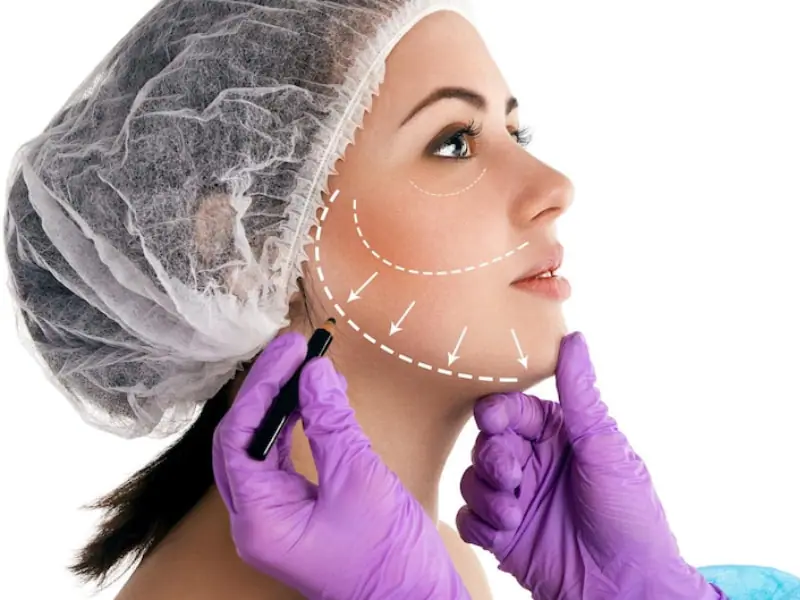
Avamedi offers multiple other services such asRhinoplasty in Iran, revision rhinoplasty in Iran.
Advantages of the Non-Surgical Facelift In Iran
The quest for timeless beauty has ushered in a new era of non-surgical facelifts, offering a plethora of advantages that have transformed the beauty industry. With the best non-surgical facelift procedures, individuals can enjoy remarkable benefits without the need for invasive surgeries and lengthy recoveries. Here, we explore the advantages of these innovative treatments, which have become the preferred choice for those seeking rejuvenation and renewal.
Natural-Looking Results
One of the most notable advantages of the best non-surgical facelifts is their ability to deliver natural-looking results. These treatments aim to enhance your existing features, restoring a youthful appearance without the artificial or “pulled” look often associated with traditional facelift surgeries. The artistry lies in preserving your unique beauty while subtly reversing the effects of aging.
Minimally Invasive Procedures
Non-surgical facelifts are minimally invasive, requiring no incisions, sutures, or general anesthesia. This means reduced risks, shorter recovery times, and minimal discomfort. Patients can often resume their daily activities shortly after their treatment, making these procedures incredibly convenient.
Immediate or Gradual Results
Depending on the specific treatment chosen, you can enjoy either immediate or gradual results. For example, dermal fillers provide instant volume and rejuvenation, while procedures like Ultherapy stimulate collagen production, leading to gradual but long-lasting improvements. The flexibility to choose the pace of your transformation is a significant advantage.
Customized Treatments
The best non-surgical facelift procedures are highly customizable. Your treatment plan is tailored to address your unique concerns and goals. Whether you want to target specific wrinkles, enhance facial contours, or achieve an overall refreshed appearance, these treatments can be personalized to meet your needs.
Short Recovery Periods
Traditional facelift surgeries often require weeks of downtime, which can be inconvenient and uncomfortable. Non-surgical facelifts, on the other hand, typically involve minimal to no downtime. This means you can return to your regular routine quickly, without the need for extended recovery periods.
Minimal to No Scarring
Since non-surgical facelifts do not involve surgical incisions, scarring is generally not a concern. This is especially appealing for individuals who wish to improve their appearance discreetly, without visible marks or scars.
Lower Costs
Compared to traditional facelift surgeries, non-surgical facelifts are more cost-effective. While the exact price varies based on the chosen treatment and location, they are generally more budget-friendly, making them accessible to a wider range of individuals.
Safe and FDA-Approved
The best non-surgical facelift treatments are safe and FDA-approved. They have undergone rigorous testing to ensure their effectiveness and safety. This regulatory approval provides peace of mind to those seeking these procedures.
Minimal Side Effects
Non-surgical facelift procedures typically involve minimal side effects. While some temporary redness, swelling, or bruising may occur, these effects are usually mild and short-lived. Patients can comfortably resume their activities shortly after their treatment.
- Rejuvenation Without the Knife
Perhaps the most significant advantage of the best non-surgical facelift is the ability to achieve facial rejuvenation without going under the surgeon’s knife. These treatments offer a path to a more youthful appearance without the risks and invasiveness associated with traditional surgeries.
How painful is breast lift recovery?
Recovery from a Breast Lift & Breast Reduction in Iran, or mastopexy, can involve some discomfort and pain. The level of pain varies from person to person and depends on factors such as individual pain tolerance, the extent of the procedure, and how well postoperative care instructions are followed. Patients typically experience some swelling, bruising, and soreness, especially in the initial days after surgery. In this article we discuss more about the pain of breast lift recovery.
What is breast lift recovery?
Breast lift recovery refers to the period of time during which a person heals and adjusts after undergoing a breast lift surgery, also known as mastopexy. Surgeons commonly prescribe pain medications to manage discomfort during the early stages of recovery. Patients need to follow the postoperative care plan provided by their surgeon, including taking prescribed medications, wearing supportive garments, and avoiding strenuous activities during the initial healing period.
While discomfort is expected, severe or prolonged pain should be promptly addressed with the surgeon. Overall, pain during breast lift recovery is temporary, and most patients find that it diminishes gradually as they progress through the healing process.
SOURCE:How painful is breast lift recovery

Avamedi offers multiple other services such asRhinoplasty in Iran, revision rhinoplasty in Iran, Buccal Fat Removal in Iran, Gynecomastia in Iran and Forehead Reduction in Iran.
Here are the key aspects of breast lift recovery:
- Immediate Postoperative Period (First Week):
- Pain Management: Patients may experience some pain and discomfort, which is typically managed with prescribed pain medications.
- Swelling and Bruising: Swelling and bruising around the breasts are common in the initial days after this Plastic surgery.
- Supportive Garments: Patients are often required to wear a surgical bra or compression garment to provide support and minimize swelling.
- First Few Weeks:
- Limited Activities: Strenuous activities, heavy lifting, and intense exercise are usually restricted during the early weeks of recovery.
- Follow-up Appointments: Patients typically have follow-up appointments with their surgeon to monitor healing progress and address any concerns.
- First Month:
- Return to Normal Activities: While light activities may be resumed, patients are advised to avoid activities that strain the chest muscles.
- Incision Care: Proper care of incision sites is crucial, including keeping them clean and following any specific care instructions provided by the surgeon.
- First Three to Six Months:
- Scar Healing: Scar healing is a gradual process, and patients may be advised on scar management techniques.
- Final Results: While some improvement is noticeable early on, the final results of the breast lift become more apparent as swelling subsides and tissues settle.
- Long-Term:
- Scar Management: Depending on the type of incisions, patients may use scar creams or silicone sheets to manage scars.
- Regular Check-ups: Regular follow-up appointments with the surgeon are important to monitor long-term results and address any concerns.
Individuals need to follow their surgeon’s postoperative care instructions diligently, report any unusual symptoms or changes, and attend scheduled follow-up appointments. The overall goal of breast lift recovery is to ensure optimal healing, minimize complications, and achieve the desired aesthetic outcome.
How painful is breast lift recovery without implants?
The level of pain experienced during a breast lift without implants can vary from person to person, and individual pain tolerance plays a significant role. Here are some general considerations:
- Mild to Moderate Discomfort:
- Patients often report experiencing mild to moderate discomfort rather than severe pain.
- Discomfort is typically associated with swelling, bruising, and tightness in the chest area.
- Pain Management:
- Surgeons typically prescribe pain medications to manage discomfort during the initial days of recovery.
- Over-the-counter pain relievers may also be recommended.
- Initial Days vs. Subsequent Weeks:
- The most intense discomfort is usually within the first few days after the surgery.
- As the days and weeks progress, the pain tends to subside.
- Individual Variations:
- Pain perception varies among individuals, and factors such as overall health, pain tolerance, and adherence to postoperative care instructions can influence the experience.
- Temporary Nature:
- The discomfort experienced during a breast lift is temporary and is part of the normal healing process.
- Following the surgeon’s postoperative care guidelines can help minimize pain and promote a smoother recovery.
It’s important to communicate openly with your plastic surgeon about any concerns or changes in pain levels during the recovery process. Surgeons can provide guidance on pain management strategies, ensure proper healing, and address any specific issues that may arise based on individual circumstances.
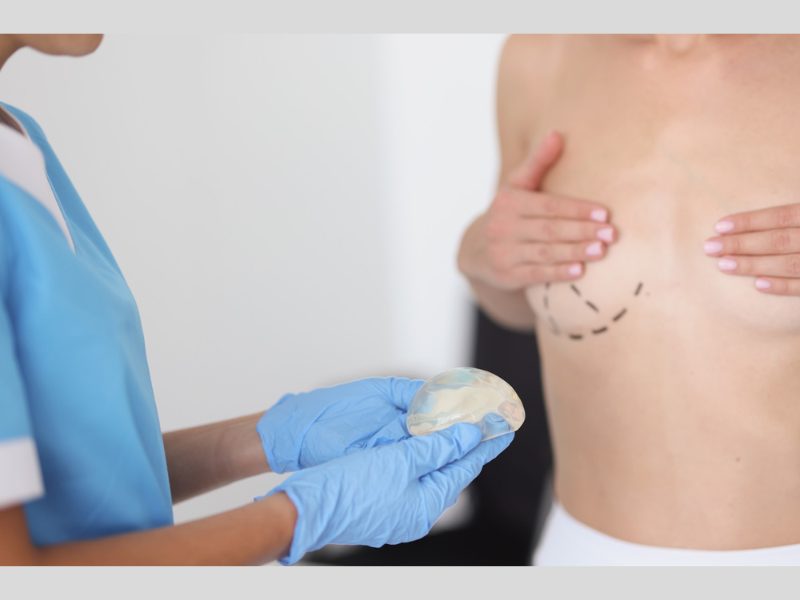
What helps with breast lift pain?
Managing pain after a breast lift involves a combination of prescribed medications, over-the-counter pain relievers, and various strategies to promote comfort and healing. Here are some common approaches to help with breast lift pain:
- Prescribed Pain Medications:
- Your surgeon may prescribe pain medications, such as opioids or other analgesics, to manage postoperative pain.
- Follow the prescribed dosage and schedule provided by your surgeon.
- Over-the-Counter Pain Relievers:
- Non-prescription pain relievers like acetaminophen or ibuprofen may be recommended.
- Ensure compatibility with any prescribed medications and follow the recommended dosages.
- Cold Compresses:
- Applying cold compresses or ice packs to the chest area can help reduce swelling and numb the area, providing relief.
- Elevating the Upper Body:
- Keeping the upper body elevated, especially during sleep, can help minimize swelling and discomfort.
- Compression Garments:
- Wearing compression garments or supportive bras recommended by your surgeon can provide comfort and reduce movement.
- Hydration and Nutrition:
- Staying hydrated and maintaining a balanced diet can support the body’s healing process and reduce inflammation.
- Avoiding Strenuous Activities:
- Following your surgeon’s guidelines on avoiding strenuous activities and movements during the initial recovery period is crucial to prevent increased pain.
- Regular Follow-Up with Surgeon:
- Attend scheduled follow-up appointments with your surgeon to monitor healing progress and address any concerns about pain or discomfort.
- Communication with Surgeon:
- If you experience unexpected or severe pain, communicate promptly with your surgeon. They can provide guidance, adjust medications if necessary, and address any potential issues.
It’s important to note that individual experiences with pain can vary, and the effectiveness of pain management strategies may differ from person to person. Always follow your surgeon’s postoperative care instructions and consult with them if you have specific concerns about pain or recovery.
Gynecomastia Treatment Without Surgery
Gynecomastia in Iran, the enlargement of male breast tissue, can be a source of physical and psychological discomfort for many individuals. While surgical intervention is often considered the most effective treatment option for severe cases, non-surgical approaches for gynecomastia treatment without surgery are available for those who prefer to avoid surgery or have milder forms of gynecomastia. These non-surgical treatments aim to address the underlying causes of gynecomastia or alleviate its symptoms without the need for invasive procedures.
Can You Get Gynecomastia Treatment Without Surgery?
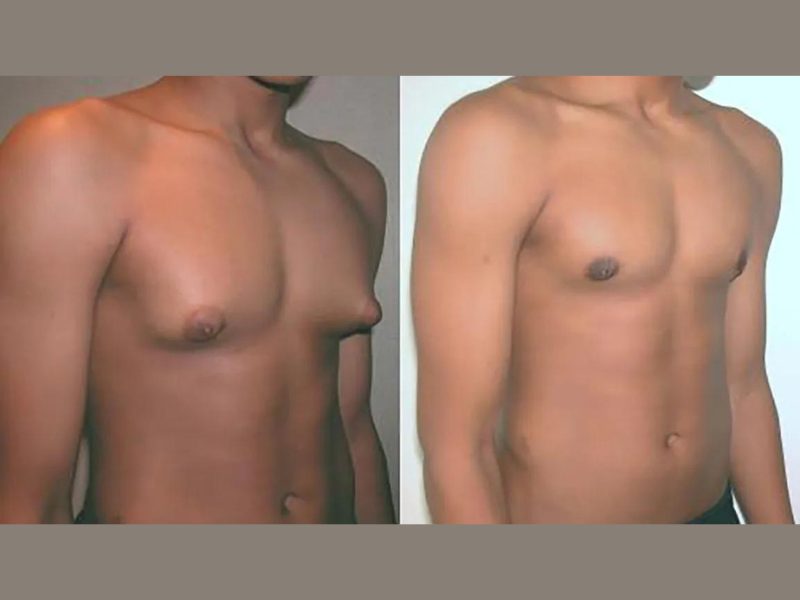
Avamedi offers multiple other services such as Rhinoplasty in Iran.
Yes, it is possible to receive treatment for gynecomastia without surgery, depending on the underlying cause and severity of the condition. Non-surgical treatment options are available and can be effective in some instances. These treatments aim to address hormonal imbalances, reduce breast tissue growth, or alleviate symptoms associated with gynecomastia. Non-surgical approaches for gynecomastia treatment may include medications, lifestyle changes, hormone therapy, compression garments, and psychological support. However, it’s important to note that the effectiveness of non-surgical treatments may vary depending on individual circumstances, and in some cases, surgical intervention may be necessary for optimal results.
Consulting with a healthcare professional or a specialist in hormonal disorders or plastic surgery can help determine the most appropriate treatment approach for your specific situation.
Does The Non-surgical Option Help With Gynecomastia?
Non-surgical options for gynecomastia treatment without surgery can be effective in some instances, but their success depends on factors such as the underlying cause and severity of the condition. Here are some non-surgical treatments and their potential benefits:
- Medications: Certain medications, such as tamoxifen, raloxifene, or aromatase inhibitors, may help reduce breast tissue growth or address hormonal imbalances that contribute to gynecomastia. These medications can be effective in some individuals, especially when hormonal imbalances are the primary cause of gynecomastia.
- Lifestyle changes: Making lifestyle modifications, such as maintaining a healthy weight, exercising regularly, and avoiding substances that can contribute to gynecomastia (e.g., alcohol, anabolic steroids), can help reduce the symptoms and severity of gynecomastia.
- Hormone therapy: Hormone replacement therapy (HRT) or testosterone replacement therapy (TRT) may be utilized to balance hormone levels and alleviate gynecomastia symptoms caused by hormonal imbalances. These treatments can be effective for individuals with hormone-related gynecomastia.
- Compression garments: Wearing compression garments, such as compression vests or shirts, can help flatten the appearance of the chest and provide temporary relief from gynecomastia. They can be beneficial for individuals who experience discomfort or self-consciousness due to gynecomastia.
- Psychological support: Gynecomastia can have significant psychological impacts. Seeking counseling or joining support groups can help individuals address body image concerns, improve self-esteem, and cope with the emotional aspects of gynecomastia.
While non-surgical treatments can be beneficial for some individuals, it’s important to note that their effectiveness may vary. In cases where gynecomastia is severe or persistent, surgical intervention may be necessary to achieve the desired results. Consulting with a healthcare professional or a specialist in hormonal disorders or plastic surgery can help determine the most suitable treatment approach based on individual circumstances.
Gynecomastia Treatment Without Surgery At Home: 7 Ways
While it is always recommended to consult with a healthcare professional for proper evaluation and guidance, here are seven potential ways to manage gynecomastia at home without surgery:
- Exercise and strength training: Engaging in regular exercise and strength training can help reduce overall body fat and promote muscle development, potentially improving the appearance of gynecomastia.
- Healthy diet: Maintaining a balanced and nutritious diet can contribute to overall weight management and potentially reduce fat deposits in the chest area. Focus on consuming whole foods, lean proteins, fruits, vegetables, and healthy fats.
- Weight loss: If excess weight is a contributing factor to gynecomastia, losing weight through a combination of diet and exercise may help reduce the size of the breasts.
- Avoiding hormone-disrupting substances: Limiting exposure to substances that can disrupt hormone levels, such as alcohol, anabolic steroids, and certain medications, may help manage gynecomastia.
- Herbal remedies: Some herbal remedies like green tea extract, turmeric, and ginkgo biloba have been suggested to have potential anti-estrogenic properties and could be explored as complementary treatments. However, their efficacy and safety should be discussed with a healthcare professional.
- Compression garments: Wearing compression garments, such as compression vests or shirts, can help flatten the appearance of the chest and provide temporary relief from gynecomastia.
- Emotional support: Gynecomastia can have a psychological impact. Seeking emotional support through counseling or joining support groups can help individuals cope with body image concerns and improve self-esteem.
It is important to note that these home-based approaches may not be practical for all cases of gynecomastia. Consulting with a healthcare professional or a specialist in endocrinology or plastic surgery is crucial for accurate diagnosis and personalized treatment recommendations.
Tips On How To Make Your Gynecomastia Less Noticeable
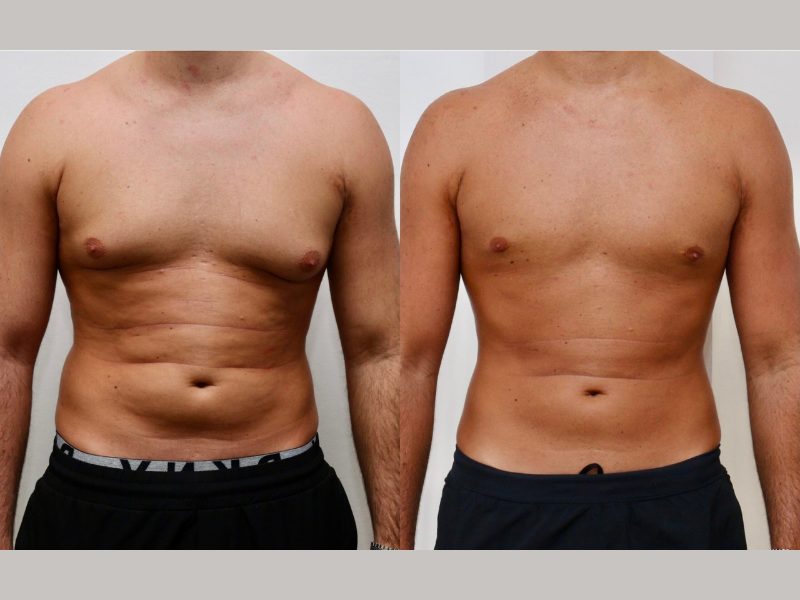
If you have gynecomastia and want to make it less noticeable, here are some tips that may help:
- Wear appropriate clothing: Choose clothing styles that can help minimize the appearance of gynecomastia. Opt for loose-fitting shirts or tops with patterns, textures, or prints that can camouflage the chest area.
- Layer clothing strategically: Layering clothing can help create visual depth and distract attention from the chest. For example, wearing a well-fitted undershirt or compression garment underneath your regular shirt can provide a smoother appearance.
- Use compression garments: Consider wearing compression vests or shirts designed explicitly for gynecomastia. These garments apply gentle pressure and can help flatten the chest area, making gynecomastia less noticeable.
- Posture and body language: Pay attention to your posture and body language. Standing up straight with good posture can help give the appearance of a flatter chest. Avoid slouching or hunching over, as it may accentuate the appearance of gynecomastia.
- Exercise and strength training: Engaging in regular exercise and strength training can help improve overall body composition and muscle tone. Specifically, targeting the chest muscles through exercises like push-ups or chest presses may help provide a more defined appearance.
- Maintain a healthy weight: Maintaining a healthy weight can help reduce overall body fat, including in the chest area. Focus on a balanced diet and regular physical activity to achieve and maintain a healthy weight.
- Confidence and self-acceptance: Remember that gynecomastia is a common condition and does not define your worth or masculinity. Cultivate self-confidence and practice self-acceptance. Embrace your body and focus on the qualities that make you unique.
Conclusion
In conclusion, gynecomastia, the enlargement of male breast tissue, can be managed without surgery through various non-surgical treatments. Gynecomastia treatment without surgery
may include medications, lifestyle changes, hormone therapy, compression garments, and psychological support. While their effectiveness can vary depending on individual circumstances, they can be beneficial for some individuals. It’s essential to consult with a professional online healthcare provider, like Avamedi, or a specialist to determine the most suitable treatment approach. Additionally, there are tips to make gynecomastia less noticeable, such as wearing appropriate clothing, layering strategically, using compression garments, maintaining good posture, engaging in exercise and strength training, maintaining a healthy weight, and cultivating confidence and self-acceptance.

